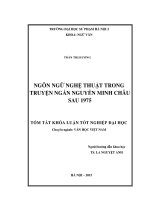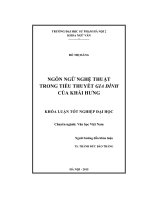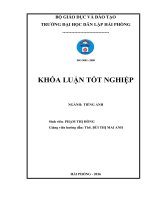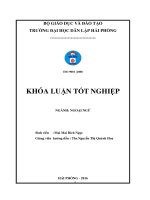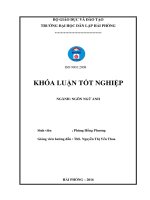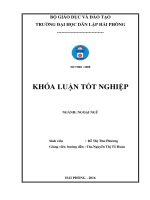Khóa luận tốt nghiệp ngoại ngữ graduation paper using projects to motivate 1st english major students to speak
Bạn đang xem bản rút gọn của tài liệu. Xem và tải ngay bản đầy đủ của tài liệu tại đây (515.44 KB, 73 trang )
BỘ GIÁO DỤC VÀ ĐÀO TẠO
TRƯỜNG ĐẠI HỌC DÂN LẬP HẢI PHÒNG
-------------------------------
ISO 9001 :2008
KHÓA LUẬN TỐT NGHIỆP
NGÀNH: NGOẠI NGỮ
Sinh viên
:Mai Mai Bích Ngọc
Giảng viên hướng dẫn : Ths.Nguyễn Thị Quỳnh Hoa
HẢI PHÒNG - 2016
1
BỘ GIÁO DỤC VÀ ĐÀO TẠO
TRƯỜNG ĐẠI HỌC DÂN LẬP HẢI PHÒNG
-----------------------------------
GRADUATION PAPER
USING PROJECTS TO MOTIVATE 1ST ENGLISH
MAJOR STUDENTS TO SPEAK
KHÓA LUẬN TỐT NGHIỆP ĐẠI HỌC HỆ CHÍNH QUY
NGÀNH: NGOẠI NGỮ
Sinh viên
Lớp
: Mai Mai Bích Ngọc
: NA1601
Giảng viên hướng dẫn: Ths.Nguyễn Thị Quỳnh Hoa
HẢI PHÒNG - 2016
2
BỘ GIÁO DỤC VÀ ĐÀO TẠO
TRƯỜNG ĐẠI HỌC DÂN LẬP HẢI PHÒNG
--------------------------------------
NHIỆM VỤ ĐỀ TÀI TỐT NGHIỆP
Sinh viên: .........................................................Mã SV:....................................
Lớp: .............................Ngành:..........................................................................
Tên đề tài: ......................................................................................................
............................................................................................
............................................................................................
............................................................................................
3
NHIỆM VỤ ĐỀ TÀI
1. Nội dung và các yêu cầu cần giải quyết trong nhiệm vụ đề tài tốt nghiệp
( về lý luận, thực tiễn, các số liệu cần tính toán và các bản vẽ).
……………………………………………………………………………..
……………………………………………………………………………..
……………………………………………………………………………..
……………………………………………………………………………..
……………………………………………………………………………..
……………………………………………………………………………..
……………………………………………………………………………..
……………………………………………………………………………..
2. Các số liệu cần thiết để thiết kế, tính toán.
……………………………………………………………………………..
……………………………………………………………………………..
……………………………………………………………………………..
……………………………………………………………………………..
……………………………………………………………………………..
……………………………………………………………………………..
……………………………………………………………………………..
……………………………………………………………………………..
……………………………………………………………………………..
3. Địa điểm thực tập tốt nghiệp.
……………………………………………………………………………..
……………………………………………………………………………..
……………………………………………………………………………..
4
CÁN BỘ HƯỚNG DẪN ĐỀ TÀI TỐT NGHIỆP
Người hướng dẫn thứ nhất:
Họ và tên:.............................................................................................
Học hàm, học vị:...................................................................................
Cơ quan công tác:.................................................................................
Nội dung hướng dẫn:............................................................................
Người hướng dẫn thứ hai:
Họ và tên:.............................................................................................
Học hàm, học vị:...................................................................................
Cơ quan công tác:.................................................................................
Nội dung hướng dẫn:............................................................................
Đề tài tốt nghiệp được giao ngày
tháng
Yêu cầu phải hoàn thành xong trước ngày
Đã nhận nhiệm vụ ĐTTN
năm
tháng năm
Đã giao nhiệm vụ ĐTTN
Sinh viên
Người hướng dẫn
Hải Phòng, ngày ...... tháng........năm 2016
Hiệu trưởng
GS.TS.NGƯT Trần Hữu Nghị
5
PHẦN NHẬN XÉT CỦA CÁN BỘ HƯỚNG DẪN
1. Tinh thần thái độ của sinh viên trong quá trình làm đề tài tốt nghiệp:
……………………………………………………………………………..
……………………………………………………………………………..
……………………………………………………………………………..
……………………………………………………………………………..
……………………………………………………………………………..
……………………………………………………………………………..
……………………………………………………………………………..
2. Đánh giá chất lượng của khóa luận (so với nội dung yêu cầu đã đề ra trong
nhiệm vụ Đ.T. T.N trên các mặt lý luận, thực tiễn, tính toán số liệu…):
……………………………………………………………………………..
……………………………………………………………………………..
……………………………………………………………………………..
……………………………………………………………………………..
……………………………………………………………………………..
……………………………………………………………………………..
……………………………………………………………………………..
……………………………………………………………………………..
……………………………………………………………………………..
3. Cho điểm của cán bộ hướng dẫn (ghi bằng cả số và chữ):
……………………………………………………………………………..
……………………………………………………………………………..
……………………………………………………………………………..
Hải Phòng, ngày … tháng … năm 2016
Cán bộ hướng dẫn
(Ký và ghi rõ họ tên)
6
NHẬN XÉT ĐÁNH GIÁ
CỦA NGƯỜI CHẤM PHẢN BIỆN ĐỀ TÀI TỐT NGHIỆP
1. Đánh giá chất lượng đề tài tốt nghiệp về các mặt thu thập và phân tích tài
liệu, số liệu ban đầu, giá trị lí luận và thực tiễn của đề tài.
......................................................................................................................................
......................................................................................................................................
......................................................................................................................................
......................................................................................................................................
......................................................................................................................................
......................................................................................................................................
......................................................................................................................................
......................................................................................................................................
......................................................................................................................................
2. Cho điểm của người chấm phản biện : ………………………..
(Điểm ghi bằng số và chữ)
Ngày.......... tháng......... năm 2016
Người chấm phản biện
7
TABLE OF CONTENT
ACKNOWLEDGEMENT
LIST OF FIGURES, CHART AND TABLES
PART 1: INTRODUCTION……………………………………………………………………………….
1. Rationale……………………………………………………………………………………………....5
2. Aim of the study…………………………………………………………………………………….6
3. Scope of the study………………………………………………………………………………….6
4. Method of study……………………………………………………………………………...……..7
5. Design of the study…………………………………………………………...............................8
PART 2: DEVELOPMENT…………………………………………………………………………….9
CHAPTER 1: THEORETICAL BACKGROUND……………………….………………………...9
I Speaking skill……………………………………………………………………………………..…….9
1.1. Definition of speaking skill...........................................................................................9
1.2. The importance of speaking skills………………………………………………………..12
1.3. The difficulties students encounter in learning speaking skills…...…………13
2. Motivation………………………………………………………………………………………….....16
2.1. Definition of motivation……………………………………………………………………...16
2.2 Kinds of motivation……………………………………………………………………………..17
2.3 Theories of motivation ……………………………………………………………………..…20
8
3. Projects…………………………………………………………………………………………………23
3.1. Definition of projects…………………………………………………………………………..23
3.2. Definition of projects based learning……………………………………………………23
3.3. Types of projects based learning………………………………………………………….24
CHAPTER 2: THE STUDY…………………………………………………………………………...26
1.1. Participant and purpose of the survey and questionnaire……………………..26
1.2. Design of questionnaire………………………………………………………………………26
1.3. Findings and discussion………………………………………………………………………27
1.4. Data and analysis………………………………………………………………………………..27
CHAPTER 3:PROJECTS TO MOTIVATE STUDENT TO SPEAK……………………....40
I Projects to practice at home…………………………………………….………………………40
1.1. Listening……………………………………………………………………..................................41
1.2. Learning through songs………………………………………………………………………41
1.3. Self-talk………………………………………………………………………………………………43
II Projects to practice at class…….………………………………………………………………44
2.1. Group discussion………………………………………………………………...………………44
2.2. Magazine design…………………………………………………………………………………45
2.3. Role-play…………………………………………………………………………………….,.…….47
9
III Some collected projects……………………………………………………...…………………48
1. Project1………………………………………………………………………………………………...48
2. Project 2………………………………………………………………………………………………..49
3. Project 3………………………………………………………………………...................................50
4. Project 4………………………………………………………………………………………………..50
5. Project 5………………………………………………………………………………………………..51
6. Project 6………………………………………………………………………..................................52
7. Project 7………………………………………………………………………………………………..52
Chapter 4: CONCLUSION.....................................................................................................53
Appendix 1.1: The survey questionnaire for students…………………………………54
Appendix 1.2: Some suggested websites…………………………………………………….57
Appendix 1.3: Some suggested songs…………………………………………………………58
Appendix 1.4: A lyric of a song…………………………………………………………………...61
List of references………………………………………………………………………………………64
10
ACKNOWLEDGEMENT
Although only my name is written on this researching paper, I know I
myself would be impossible to make it without helps of contributors.
Foremost, I would like to express my deepest appreciation to my
advisory teacher Ms Nguyen Thi Quynh Hoa, M.A, for her passionate
enthusiasm and insightful guidance that she has given me in the process of
doing my thesis. She is always willing to answer every question of mine and
help me to find the most effective ways to complete my task successfully. I
have had many chances to broaden my knowledge thanks to her. It is such an
honor of mine to have her as my supervisor.
Secondly, I am deeply grateful to Ms Rosy Nguyen who has made a great
contribution in helping me with my thesis. She is always like a sister who not
only gives me precious advice about study but also cheers me up whenever I
am down.
Last but not least, I would be nothing if I were not my mother’s
daughter. Through this thesis, I would like to thank her for supporting me all
the times. No matter how hard her life is, she tries her best to provide me a
proper education and gives me opportunities to indulge my passion. I much
appreciate that.
11
PART I: INTRODUCTION
1. Rationale
English is a dominant language which becomes more and more common
in over the world. There is a fact that about 1,500,000,000 people in the world
speak English, while another 1,000,000,000 are still learning English.
Therefore, English is considered as a crucial tool to approach to the world’s
advantageous opportunities. If people are able to communicate in English,
they can connect themselves to the world. More importantly, the purpose of
using English in diplomacy, trade, science and technology and so on is also
another obvious proof of its significant role.
Vietnam is not an exception; especially we have joined many
organizations such as APECT, WTO, ASIAN and many other international
groups. To this point, it is essential for Vietnamese students to learn English
because if they have a good understanding and communication skill in
English, it is more likely that they might have many communication chances to
find a high-quality job as well as communicate with people from different
nations in all over the world.
When it comes to learning English: speaking, listening, reading and
writing are 4 basic skills. While the three other skills are prominent in
obtaining a wholesome English competence, speaking skill is always regarded
as one of the most important skills. It goes without saying that, in terms of
learning any language, the central purpose of every learner mainly is to
communicate. Thus, it is undeniable that speaking skill should be made
priority for English learners because it seems that if they are productive
12
communicators, there will be a high possibility for them to get settled and
well-paid jobs.
However, to master this skill is still an issue for almost students in
Vietnam. At Hai Phong Private University, for instance, a large number of
students encounter many difficulties with their speaking skills such as lack of
motivation and environment, fear of speaking, fear of making mistakes and so
on. As the difficulties mention above, the researcher anticipated these
weakness is attributable to the lack of motivation and confidence of Englishmajor students at Hai Phong private university. In order to address this, the
researcher adopts creatively ‘project-based learning’ as an active learning
model to increase the appropriateness and the effectiveness for students. Deci
and Moller (2005) state that project based learning concerns much about
student’s motivation which can help students develop their intrinsic
motivation and take part in learning activities for “the spontaneous feelings of
interest and enjoyment.” (Deci and Moller, 2005: 582). Intrinsic motivation
means that students might motivate themselves to engage in learning. As a
result of this, students seem to solve the problem of lacking motivation.
Hopefully, this graduation paper might be useful for anyone who is interested
in speaking skill.
2 Aim of the study
This graduation paper is written to find out:
+features and characteristics of speaking skills
+difficulties of students when learning speaking skills
13
+student's perception of projects used to motivate their speaking skill
+the effectiveness of using those projects
3. Scope of the study
In terms of learning English, there might be many problems related not
only to speaking skills but also to other skills learners might usually confront.
However, due to limitation of time, knowledge and other shortages, it is
impossible to deal with difficulties of all skills. In regarding to this, the study
will be focused on speaking skill only. The participants involved in this
research are and two English major classes of Hai Phong Private University.
The participants are all freshmen so that they can give objective opinions to
have their problems found out. From then, suggested projects somehow can
be more practical and relevant.
4. Method of study
To carry out the research, many references and books relating to
speaking skills and projects to motivate students have been approached. Also,
searching on the Internet was used for having a deeper understanding about
specific details. Besides, a survey was conducted to find out the data for
analyzing in this thesis. The participants are first year students of the English
Department because English is absolutely essential for them to use and they
are likely to use it more frequently than other non-major students. When
students use English regularly, they tend to confront with common problems
or difficulties that might hinder them to learn speaking skills effectively.
Therefore, it deems to be more objective to carry out the survey of English
major students. This might help to have a more profound effect during
14
constructing my dissertation. As a result of it, it might be easier for me to
suggest sensible projects for students to give them more encouragements and
motivations so that they can effectively arouse themselves to speak.
5. Design of study
The dissertation is divided into 3 main parts: introduction, development
and conclusion.
In terms of the introduction, it deals with the reason, the scope and the
design of the study.
Moving onto the second part, the development section, the graduation
paper will focus on theoretical background. A range of definitions regarding
speaking, projects and motivations will be mentioned in this chapter and a
collected survey from Hai Phong Private University will be analyzed to find
out the difficulties of student when it comes to learning speaking skills.
Finally, some suggested projects to motivate students to speak will be
recommended for conclusion part.
15
PART 2: DEVELOPMENT
Chapter 1: Theoretical background
I. Speaking skill
1.1. Definition of speaking skill?
Speaking skill is an important skill when learning a language. It involved
the speaker’s utterance management and construction in order to understand
each other when it comes to speaking. Speaking is an interactive process of
constructing meaning that involves producing, receiving and processing
information (Brown, 1994; Burns & Joyce, 1997). Its form and meaning are
dependent on the context in which it occurs, including the participants
themselves, their collective experiences, the physical environment, and the
purposes for speaking. It is often spontaneous, open-ended, and evolving
(Maryann, 1999, p.1).
When someone speaks to other person, there forms a relationship. The
relationship itself is reflected and built through communication. Wilson
(1983:5) expanded this by stating, “speaking as development of the
relationship between speaker and listener. In addition, speaking determines
which logical linguistic, psychological and physical rules should be applied in a
given communicate situation”. To meet the purpose of communication, the
speaker needs to express exactly what he/she is going to speak. That speaker
has to notice the influence of his/her speech on the listeners, whether they
understand the speaker’s speech or not, it means that, the listeners also can
get the rule of speaking related to in general or individual
16
According to the opinions above, the researchers indicate that, when
someone says something, it is crucial for that person to be aware of what
he/she is mentioning about. In relation to this the speaker should leave space
for the responders to jointly construct the conversation by inviting new topics
in order to achieve a more effective conversation.
Speaking skill is always used more regularly in comparison to listening, reading
and writing. There is also a correlation between speaking and listening “the
relationship between speaking and listening has been extended to the assumption
that speaking and listening are positively correlated“(Brillhart,1965, p.2).To
support the relationship between speaking and listening,Tarigan (1990, p.34)defines “[s]peaking is a language skill that is developed in child life, which is
produced by listening skill, and at that period speaking skill is learned. Similarly,
Stern (in Risnadedi, 2001, p.56-57)considers the definition of speaking through
watching a small child’s speech development. First he listens, then he speaks,
understanding always produces speaking. Therefore, this must be the right order of
presenting the skills in a foreign language learning process. In this learning of
language included speaking, there is an activity of speaker or learner and it has to
have an effect to build speaker’s or learner’s desires, express how his/her feeling
and acting out his/her attitudes through speaking. Thus learning of speaking cannot
be separated in leaning languages. Also, a research has proven that speaking skill
can help 3 other skills develop. “[S]peaking can help the development of reading
17
competence(Hilferty: 2005), the development of writing(Trasel and Severino,
2004) as well as the development of listening skills(Regina,1997).
Speaking and writing is regarded as “productive skill” in comparison
with “receptive skill” in terms of reading and listening (Shiamaa,2006, p.14).
Unlike listening, reading and writing speaking are assumed to be to the most
difficult skills. When learners write or read something, which does not require
learners to response right then. It is impossible for the speakers to revise and
it seems that you might not have enough time to prepare for your speech
carefully like when you write.
Whilst Pendidikan Nasional stated, based on Competence Based
Curriculum speaking is one of the four basic competences that the students
should gain well. It has an important role in communication. (Departmen
Pendidikan Nasional, 2004 p.1). In carrying out speaking, students face some
difficulties; one of them is about language its self. In fact, most of students get
difficulties to speak even though they have a lot of vocabularies and have
written them well. The problems are afraid for students to make mistakes.
While Wallace (1978) stated that oral practice (speaking) becomes
meaningful to students when they have to pay attention to what they are
saying. Thus, the students can learn better on how to require the ability to
converse or to express their ideas fluently with precise vocabularies and good
or acceptable pronunciation.
Speaking ability is the students’ ability in expressing their ideas orally,
which is represented by the scores of speaking. Speaking is only an oral trail
of abilities that it got from structure and vocabulary, Freeman (in Risnadedi,
18
2001) stated that speaking ability is more complex and difficult than people
assume, and speaking study like study other cases in study of language,
naturalize many cases to language teachers.
In conclusion,speaking skill is always considered as a domain of
language and linguistic proper. Therefore, Clark and Clark (in Nunan, 1991,
p.23) stressed, “speaking is fundamentally an instrument act”. Speakers talk in
order to have some influences on their listeners. It is the result of teaching
learning process. Students’ skill in conversation is mainly aimed at in terms of
teaching speaking skill, it becomes vitally aspect in language teaching learning
success if language functions as a system for conveying meaning, as Nunan
(1991, p.39) states that the successful in speaking is measured through
someone’s ability to carry out a conversation in the language.
1.2. The importance of speaking skills
It is hard to describe a thing without speech, if we don’t use language to
express our mean or purpose to do something, it might be distorted or
difficult to get. Thus, speaking is always considered the most crucial action of
human being. There might be no other effective way to communicate than
speaking.
The four basic skills of listening, speaking, reading and writing are all
connected. It is essential to be proficient in all of these skills to be a competent
communicator. However, it is worth mentioning that speaking skill tends to
help the learners benefit more with some specific advantages. The ability to
express thoughts, emotions, and so on can provide a learner with these
followingadvantages:
19
- Ability to hold the leadership. Business managers, educators, military
leaders, lawyers, and many others leaders need to develop their speaking
skills so that they are capable of mastering public speaking. Speaking clearly
and confidently can help them get the attention of an audience, providing the
precious opportunity for those speakers to transfer their messages and make
them well-known by their speech. Wise and successful speakers are who can
gain and then hold the attentions of their audiences.Also how well-chosen the
speakers select the vocabulary, organized and expressed things can determine
the level of impact made after the speech.
- The ability to be outstanding. When it comes to speaking skills, everyone
tends to think of it as a common skill. However, ability to excel and to speak
English effectively and confidently is not an ordinary ability. Many people are
extremely afraid of public speaking. As a research shows that more than a half
of all population in the world are terribly afraid of public speaking while
others are not so competent to form thoughts into sentences and make those
words convincing. More notably is that in the world there are not so many
talent speakers but if a speaker whose skills are good and developed with
constant opinions and much effort can stand out.
- Ability to be popular. A well-developed speaker can strengthen his
negotiation skills. That speaker can sign many important contracts and bring
about profits not only for his company but also himself. Additionally, his selfconfidence is improved as well as a growing sense of comfort,which comes
from speaking in front of big group of audiences. The fame for excellent
speech in speaking can accumulate day by day, thereby creating a certain trust
of the speaker. “Speaking skills can enhance one’s personal life; thereby
20
bringing about the well-rounded growth we should all seek” (Gerald
Gillis,2013, p.2).
1.3. The difficulties students encounter in learning speaking skills
When it comes to speaking, students might confront a variety of
difficulties.Hetrakul (1995) stated that the first cause that makes the students’
speaking English difficulty is that the environment does not support the
students to speak English frequently. The environment here means the people
outside the class. Those people may think that the students just want to show
off when they speak English for daily conversations. The response that the
students get makes them loose their self-confidence to improve their
speaking. The second cause is problem with grammar. Hetrakul said that
grammar is also very important for students when learning speaking skills;
many students are quite confused with words usage. If they want to master
English, it is necessary for them to use grammar appropriately so that they
can produce meaningful sentences.
Similarly, Rababa’h (2005) also pointed out that there are many factors
that cause difficulties in speaking English among EFL learners. Some of these
factors are related to the learners themselves, the teaching strategies the
curriculum, and the environment. For example, many learners lack necessary
vocabulary to get their meaning across, and consequently, they cannot keep
the interaction going. Inadequate strategic competence and communication
competence can be another reason as well for not being able to keep the
interaction going.
21
Some learners also lack the motivation to speak English. They do not see
a real need to learn or speak English.
While Ur (1996) pointed out 4 main problems:
1. Inhibition, speaking requires real-time exposure to an audience.
Learners always try to speak their mother tongue in the classroom than
speak English. They are afraid of making mistakes then somehow they
would be teased or laughed by their classmates
2. Nothing to say. It is very common for every learner.They always
complain that they cannot think of any idea. Although they notice the
importance of English, they still have no clear motivation to speak at
classroom. It is hard for them to express themselves even when being
asked to do so.
3. Low or uneven participation. A person can take all time of speaking
activities. Thus, the others might not have chances to speak, or even
they cannot speak any word.
4. Mother-tongue use, many learners are too shy to use English in front of
class. They tend to prefer using mother tongue than English because
they do not have to spend much time to think.
Furthermore, all the other subjects are in Arabic, and English is seen as
an academic subject only, which means exposure to the English language is
insufficient. Similarly to Vietnamese students when they have to learn almost
subjects in Vietnamese. As a matter of fact, this problem should be prioritized
to solve. Besides,the lack of a target language environment can be considered
22
another problem, which of course results in a lack of involvement in real-life
situations. Not allowing learners to participate in discourse can be another
reason for speaking difficulties. Learners need both to participate in discourse
and to build up knowledge and skills for participation‖ in order to learn
discourse skills (Cameron, 2001, p.36)
Also, there are a number of factors relating to speaking skills to be
considered for effective English speaking performance. Pronunciation,
vocabulary, and collocations are emphasized as important factors to develop
fluency for EFL speakers. Providing students with a variety of situations and
frequent speaking tasks plays a significant role in the improvement of
students’ fluency when speaking (Tam, 1997)
There are some difficulties pointed out by linguistics. Those barriers
seem common for every English learner. Therefore, it is very necessary to use
some projects and motivations to help students solve their problem and
engage in learning.
2. Motivation
2.1. Definition of motivation
Wikipedia defines that motivation “is a theoretical construct used to
explain behavior. It represents the reasons for people's actions, desires, and
needs. Motivation can also be defined as one's direction to behavior, or what
causes a person to want to repeat a behavior and vice versa.”
23
"The term motivation refers to factors that activate, direct, and sustain
goal-directed behavior... Motives are the "whys" of behavior - the needs or
wants that drive behavior and explain what we do. We don't actually observe
a motive; rather, we infer that one exists based on the behavior we
observe."(Nevid, 2013,p.1)
According to Kendra Cherry (2016, p.1)“motivation is defined as the
process that initiates, guides, and maintains goal-oriented behaviors.
Motivation is what causes us to act, whether it is getting a glass of water to
reduce thirst or reading a book to gain knowledge. Motivation involves the
biological, emotional, social and cognitive forces that activate behavior. In
everyday usage, the term motivation is frequently used to describe why a
person does something.”
In addition, “motivation is the crucial force which determines whether a
learner embarks in a task at all, how much energy he devotes to it, and how
long he preservers” (Littlewood, 1984, p.53). “The development of
communicative skills can only take place if learners have the motivation and
opportunity to express their own identity and relate with the people around
them.
In conclusion, “motivation “are the "whys" of behavior - the needs or
wants that drive behavior and explain what we do” (Nevid,2013, p.1). While,
in the educational environment for particular, motivation is a crucial tool to
motivate student to take part in various ranges of activities or stimulate their
interest in the lessons.
2.2. Kinds of motivation
24
2.3. There are 2 kinds of motivations that Wikipedia classifies
a) Intrinsic motivation
“Intrinsic motivation has been studied since the early 1970s. Intrinsic
motivation is the self-desire to seek out new things and new challenges, to
analyze one's capacity, to observe and to gain knowledge”. It is driven by an
interest or enjoyment in the task itself, and exists within the individual rather
than relying on external pressures or a desire for reward. The phenomenon of
intrinsic motivation was first acknowledged within experimental studies of
animal behavior. In these studies, it was evident that the organisms would
engage in playful and curiosity driven behaviors in the absence of reward.
Intrinsic motivation is a natural motivational tendency and is a critical
element in cognitive, social, and physical development. Students who are
intrinsically motivated are more likely to engage in the task willingly as well
as work to improve their skills, which will increase their capabilities. Students
are likely to be intrinsically motivated if they:
+ Attribute their educational results to factors under their own control,
also known as autonomy or locus of control
+ Believe they have the skills to be effective agents in reaching their
+ Desired goals, also known as self-efficacy beliefs are interested in
mastering a topic, not just in achieving good grades
An example of intrinsic motivation is when an employee becomes an IT
professional because he or she wants to learn about how computer users
interact with computer networks. The employee has the intrinsic motivation
to gain more knowledge. Traditionally, researchers thought of motivations to
25



